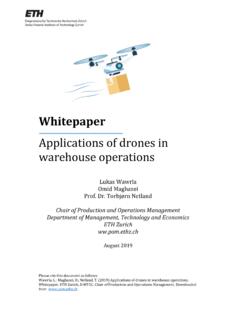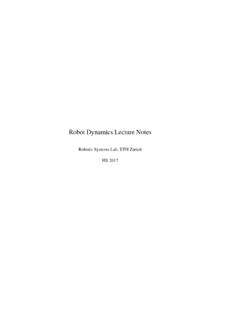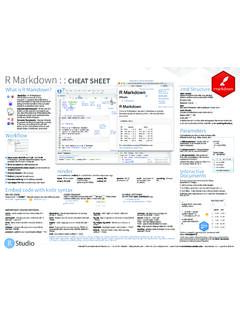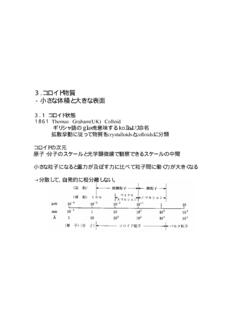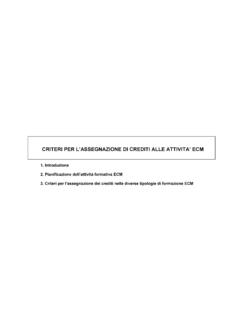Transcription of Filtration, 1. Fundamentals - ETH Z
1 2012 Wiley-VCH Verlag GmbH & Co. KGaA, WeinheimArticle No : b02_10 filtration , 1. FundamentalsSIEGFRIEDRIPPERGER,Gonbach, GermanyWALTERG oSELE,Heidelberg, GermanyCHRISTIANALT,M unchen, of the Pressure Drop over theFilter Medium and/or the Filter Cake.. of Filter Resistance and CakePermeability: The Darcy Equation .. Equation of Kozeny and Cake Filter Equation .. of Experiments withLinear Diagrams .. Diagram in the Differential Form.. Diagram in Integrated Form .. from Linearity .. Cake filtration .. filtration and other Modes Blocking filtration .. and Standard Blocking filtration Evaluation of Experimental Data filtration Mechanisms .. and Sizing of Deep Bed Filters . of Filter Effects, Mass of Experimental Procedures and Intermediate Deliquoring before of Filter by Gas Saturation of Filter Cakes.
2 Of Deliquoring by Gas Pressure.. Solution for Coarse,Incompressible Cakes .. Scale-Up of Deliquoring by GasPressure .. and Cracks in Filter by filtration Cycle Forces and Forces BetweenParticles and Filtermedia, DLVO Simulation of Filtrationand Cake of Unfilterable Suspension. of Upstream Steps(Crystallization, Precipitation).. of Flocculants (Polyelectrolytes) of of Alternatives to of a Filter 708 SymbolsA:cross-sectional area, filter area, m2a:resistance of a porous mediumaH: cake resistance relative to cakethickness, m 2am: cake resistance relative to dry mass,m/kgB:creep constantb:resistance of the filter medium, m 1C:creep constantc:Concentration of the suspensioncV:solid concentration as a part of totalvolumedh:hydraulic pore diameter of a porousstructuredpore: capillary diameter, mdS:Sauter mean diameter of particles, mE:electrostatic potential at the solidssurface, Ve:porosity of the porous mediumH:cake thicknessI:ionic strength, mol/LDOI.
3 TerminologyFiltration is the separation process of removingsolid particles, microorganisms or droplets froma liquid or a gas by depositing them on afiltermediumalso called aseptum, which is essentiallypermeable to only the fluid phase of the mixturebeing separated. The particles are depositedeither at the outer surface of the filter mediumand/or within its depth. The permeation of thefluid phase through the filter medium is con-nected to a pressure chapter deals only with filtration process-es of solid liquid mixtures (suspensions, slurries,sludges). For the treatment of gases by filtrationsee!Dust , however, purification of a liquidor gas is called filtration even when no semiper-meable medium is involved (as in electrokineticfiltration).The liquid more or less thoroughly separatedfrom the solids is called thefiltrate, effluent,permeateor, in case of water treatment,cleanwater.
4 As in other separation processes, theseparation of phases is never complete: Liquidadheres to the separated solids (cakewithresid-ual moisture) and the filtrate often contains somesolids (solids content in the filtrateorturbidity).The purpose of filtration may be clarificationof the liquid or solids recovery or both. Inclar-ificationthe liquid is typically a valuable productand the solids are of minor quantity and are oftendiscarded without further treatment. If however,the solids are to be recovered, they very oftenhave to be washed, deliquored and dried (seeFig. 1). In this article,washingmeans thecleaning of a product (filter cake) and it isdistinguished from cleaning parts of the filteritself, which will be calledrinsing( , rinsinga filter screen or a filter cloth by jets of water). Afurther distinction is to be made contaminants from the pores between theJ:Boucher s filterability index, m 3KH: proportionality volume of cake/volumeof filtrate, m3/m3Km: proportionality mass of cake/volume offiltrate, kg/m3KN: proportionality number of particles/volume of filtrate, m 3k:permeability of the filter cake 1/aH,m2L:distance from the inlet face of the filterbed, ml:filter coefficient of deep bed filters, m 1m:mass of dry filter cake, kgmi:molar concentration of ion i , mol/LN:number of open poresn:compressibility factorh:viscosity, Ns/m2pL:pressure in the liquid, PapS:compressive stress on the solids, PaDp: pressure droppc:capillary pressure, Papce: capillary entry pressure, Papci:capillary suction pressure, Paq:exponent describing blocking behaviorr.
5 Distance from the solids surface, mrD:Debye length, mSR:reduced saturationS:saturation (volume of liquid/volume ofpores)Sv:specific inner surfaceS :irreducible saturationtreg: regeneration time for cleaning and pre-paring a run, sQ:dimensionless timeUc: consolidation rateV:volume of filtrate, m3_V:volumetric flow rate, m3/hV/A: specific flow rate or filtration velocityzi:valency of ion i z:surface potential, VY:energy potentialIndicesav:averagee:end of filtrationH:related to cake thickness (height)L:liquidloc: localm:related to cake massN:numberS:solidw:wash liquorpore: pore (volume)678 filtration , 1. FundamentalsVol. 14particles of a filter matter out of the solid particles them-selves (!Liquid Solid Extraction). The termdryingmeans thermal drying, while the elimina-tion of liquid from the filter cake by mechanicalforces is calleddeliquoringordewatering, ,deliquoring by a pressurized gas or by processes can be classified in accor-dance with different of particle retentionThe particles can be separated on the outersurface of the filter medium (surface filtra-tion, cake filtration ) or inside of the filtermedium (depth filtration , deep bed filtration ) of the pressure differencePressure filtration , vacuum filtration , gravityfiltration, centrifugal modediscontinuous, continuous, filtration and static (normal) filtra-tion.
6 In case of dynamic filtration are duringthe filtration process mechanisms activewhich helps to reduce the build up of a filtercake. The most common dynamic filtrationprocess is example water filtration , beer filtrationFiltration is effected by application of a pres-sure difference which can be produced byapressurized fluid,byavacuum, by thegravityor bycentrifugal force(see Fig. 2).Pressurefiltrationtypically requires a pump for deliveringthe suspension to the filtrationrequires a vacuum pump. The pump evacuatesthe gas from a filtrate receiver, where the filtrateis separated from the gas. The filtrate is drainedeither by a barometric leg of at least 8 to 10 m orby a pump that is able torun on snore( witha deficiency of feed liquid so that it tends to drawin air). In some cases the liquid is allowed to flowthrough the filter medium only by gravity (gravi-ty filtration ).
7 Centrifugal filtrationis done inperforated centrifuge rotors (!Centrifuges,Filtering).In case ofvacuum filtersthe cake is freelyaccessible. This facilitates automatic cake han-dling. However, vacuum filters cannot handle hotliquids, or solvents with high vapor pressure. Thepressure difference across vacuum filters is verylimited, and the residual moisture of the filtercake is higher than with pressure high pressure differences. They arepreferred when the product must be kept ina closed system for safety reasons, or if theresidual moisture content is important. The han-dling of the filter cake is obviously more difficultin a pressure filter. filtration bycentrifugalforcerequires more technical equipment, but asa general rule it yields solids with lower residualmoisture (!Centrifuges, Filtering).During adynamic filtrationthe collectedsolids on the filter media are continuouslyremoved, mostly with a tangential flow to thefilter medium (cross-flow filtration ).
8 Cross-flowfiltration is a standard operation with membranesas a filter medium. The flow parallel to the filtermedium reduces the formation of a filter cake orFigure processing chainFigure forces in filtrationVol. 14 filtration , 1. Fundamentals 679keeps it at a low level. So it is possible to geta quasi-stationary filtrate flow for a long models have been developed todescribe the physical process of filtration . Thischapter concentrates on four idealized filtrationmodels depicted in Figure filtrationis the most frequently usedmodel. Here it is assumed that the solids aredeposited on the upstream side of the filter me-dium as a homogeneous porous layer witha constant permeability. As soon as the first layerof cake is formed, the subsequent filtration takesplace an the top of the cake and the mediumprovides only a supporting function.
9 Thus, if theflow rate dV/dtis constant, the pressure drop willincrease linearly, proportional to the quantity ofsolid deposited. This model can be applied espe-cially for all hard, particulate pressure drop iscaused by solid particles blocking pores. Soft,gelatinous particles retained by a sieve exhibitsuch a behavior. If the flow rate dV/dtis constant,the pressure drop increases exponentially withthe quantity filtered, the number of open poresasymptotically approaching zero. The pores maybelong to a filter medium (screen or filter layer) orit may be pores within a filter cake of coarseparticles, which are blocked by migrating Bed or Depth par-ticles are retained in a deep filter layer. This takesplace for example in sand filters for clarificationof drinking water, which retain even colloidalparticles.
10 The typical effect of deep bed filtrationis adhesion of solids to the grains of the filterlayer. Only rather big particles are retained bythe screening effect. When the filter bed has beensaturated with solids, the solids concentrationin the filtrate leaving the bed progressivelyapproaches that of the incoming cross-flow filtra-tion the suspension flows with high speed tan-gentially to the filter medium surface, preventingthe formation of a filter cake. Only a small flow ofliquid passes through the filter medium. A certainlayer of solids accumulates in the boundary layeron the filter surface, and reduces the flow offiltrate. After an initial period, a dynamic equi-librium is established between convectivetransport of solids to the filter surface and re-moval of solids by hydrodynamic forces actingon the particles due to turbulence and filtrationis the antonym to depthfiltration.


